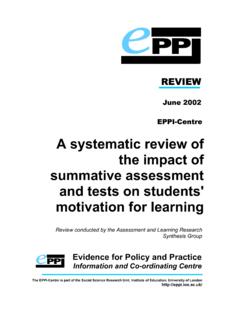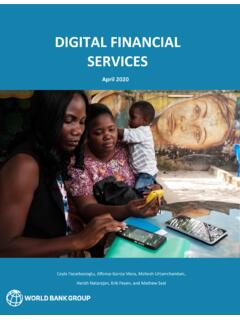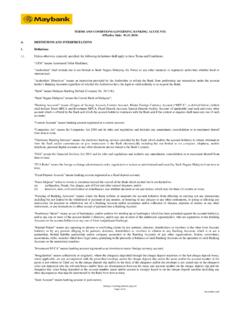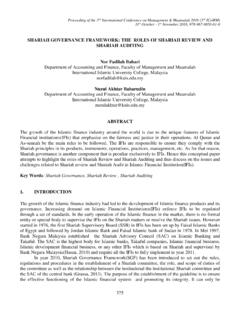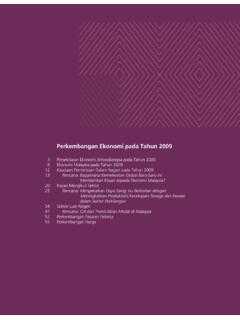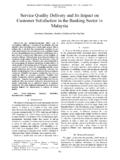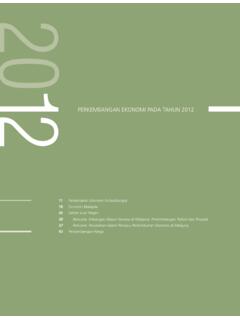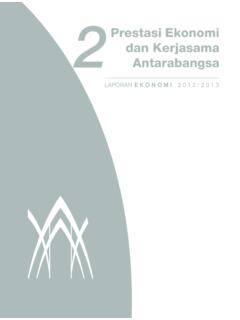Transcription of CHAPTER 1 THE RESEARCH CONTEXT - University of Stirling
1 CHAPTER 1 THE RESEARCH CONTEXT Introduction This CHAPTER sets the scene for this RESEARCH and is divided into seven sections. The first two parts discuss the development of studies in service sector generally and the banking industry in particular in malaysia since its independence until the present. Following this, there is a discussion of the position of service quality and service climate RESEARCH in malaysia and how these affect the researcher s intention in respect of both these fields. The world of services The services sector is a major contributor to malaysia s GDP growth comprises finance (finance, insurance, real estate and business services) as one of its sector indicators (Economic Report, 2001-2007; Productivity Report, 2001-2007).
2 It continued to record substantial growth in 2005 and 2006 due to higher consumer spending with rising disposable income (Economic Report, 2001-2007) and high tourist arrivals (Mohd. Roshdi, 2007), despite the temporary SARS outbreak (Koay, 2008) and the Iraq war (Utusan malaysia , 2005a; 2005b). 1 In the Ninth Plan 2006-2010, which was announced by Malaysian Prime Minister, highlighted the importance of human capital as the strategic thrust of the nation. The main contributor of human capital is the workforce, which has to be competent, innovative, motivated and capable of high productivity (Chin, 2004) in order for an organization particularly services sector to achieve organizational excellence.
3 Hence, organizations must encourage their employees to be more knowledgeable, customer focused, capable of team working (Wright and Brauchle, 1994), flexible and have the ability to work independently. This can be achieved through maximizing the benefit of employee training and organizations have to ensure the suitability of training to their employees needs. This allows maximum benefit of training to be gained and provides a foundation for the transferability of knowledge (Kwang et al, 1999). The knowledge and skills of the workforce are essential for business survival, particularly in the services sector.
4 Customers requirements and demands for world class products and services are increasing. To meet this demand, the services sector requires workforce with a new mindset to ensure high quality service delivery and instill greater professionalism in service provision (Sinclair and Zairi, 2001). It is important for organizations to hire the right people for the task. An organization needs to create a new approach for the work system to place greater emphasis on performance that is comprehensive, market driven, customer focused and multi-skilled. For this reason, organizations have to establish a beneficial learning culture comprising multi-skilling, 2including customer service and technology skills.
5 Skill levels in the services sector can be enhanced through a specific training centre (Juran, 1993a; Tang and Zairi, 1998). From the employee perspective, multi skilling helps to sustain self value and high employability, better understanding of integrated organizational activities and, ultimately, customer services are delivered in a more timely and cost-effective manner. This must be accompanied by a strong work culture, a change in mindset and positive work attitudes. The culture of excellence and the quest for continuous productivity need to be promoted intensely. The success of the services sector relies heavily on the human capital which contributes to the innovativeness and competitiveness of the industry.
6 Together with the assistance of highly efficient human resource strategies and processes, the organization will be able to create a leading edge in human capital terms. The rapid growth of information and communication technology, including telecommunications, has resulted in the availability and wider range of services in this industry. The application of information and communication technology (ICT) is essential in the services sector as it increases the competitiveness of businesses, enabling cost reduction and the creation of a larger customer base. Among the ICT applications used are web-based Electronic Data Interchange (EDI) in the logistics sector and e-banking facilities in the finance sector.
7 For the change to be beneficial, the use of technology should be business driven and complement the business needs. The optimum use of appropriate technology will enable the sector to shift to higher 3growth, improve customer services, increase market share and leverage existing resources to generate new revenue and gain a competitive edge. The migration of the economy from price-economy to knowledge-economy requires organizations to change their way of doing business. Customers expectations and needs are becoming more demanding and sophisticated. To understand the requirements of their customers, service organizations should develop and improve their strategic service division.
8 Organizations need to identify strategic service vision and direction to coordinate activities, create a common understanding on how the overall business process systems work and improve over time, and to apply changes successfully. As businesses are increasingly globalized (Juran, 1993b), organizations must employ new methods, new skills and knowledge through e-business. In the knowledge-based economy, success in this fast-changing era will depend on the ability of both organizations and individuals to exploit knowledge, creativity and skills. Apart from this, greater efforts should be made to adopt better management systems to enhance the quality of service delivery (Newall and Dale, 1991).
9 Service providers also have to look into speed of action as their focus in providing efficient and effective services, which requires a reduction of bureaucracy and paperwork. The services sector is facing increasing pressure as the market becomes more competitive as a result of the rapid growth in technology, particularly technology 4associated with globalization. The sector needs to enhance productivity improvement continuously and sequentially to meet these challenges. Related to these factors are a number of issues and challenges that need to be addressed for long-term sustainability of the services sector. The success of any quality service improvement requires coordinated interfaces among all units and departments in the organization (Tang and Zairi, 1998).
10 Such improvement also entails more commitment from all parties to plan and implement using information and data management that keep track of immediate and long term objectives (Juran, 1993). Improving service quality and understanding customer needs and expectations is important to retain existing customers and win new ones. An organization must provide customers with outstanding quality services that meet or exceed their demands and expectations, reasonable prices and on-time delivery. To attain this level of excellence, organizations continually need to examine their service quality systems to see if they are responsive to changing customer requirements.
